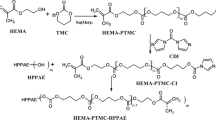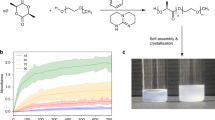Abstarct
Poly(phenylquinoline)-block-poly(ethylene glycol)(PPQ-b-PEG) rod-coil block copolymers possess the self-assembly behavior in selective solvents. The copolymers in the mixed solvents ofV(trifluoroacetic acid, TFA):V(dichloromethane, DCM) = 1:1 can self-assemble into polymer hollow microspheres with diameters of a few micrometers. The polymer hollow microspheres are monodisperse, and the diameters of them increase with an increased polymerization degree of the PPQ rigid-rod block. The solution concentration has no effect on the microsphere diameter, but spherical surface shows burrs when the solution concentration is too low. It has been found that the obtained dilute solution has the strongest absorption peak at 376 nm and strongest emission peak at 604 nm by the spectroscopy analysis.
Similar content being viewed by others
References
Yuan, J., Chen, S., Feng, L., The self-assembly of block copolymer and its applications in fabricating nanometerials (II), Polymer Bulletin (in Chinese), 2002, 2: 9–28.
Booth, C., Attwood, D., Effects of block architecture and composition on the association properties of poly(oxyalkylene) copolymers in aqueous solution, Macromol. Rapid Commun. 2000, 21: 501–527.
Patri, A., Majoros, I., Baker, J. R. et al., Dendritic polymer macromolecular carriers for drug delivery, Current Opinion in Chem. Bio., 2002, 6: 466–471.
Savic, R., Luo, L., Eisenberg, A. et al., Micellar nanocontainers distribute to defned cytoplasmic organelles, Science, 2003, 300: 615–618.
Antonietti, M., Forster, S., Hartmann J. et al., Novel amphiphilic block copolymers by polymer reactions and their use for solubilization of metal salts and metal colloids, Macromolecules, 1996, 29: 3800–3806.
Moffitt, M., Eisenberg, A., Scaling relations and size control of block ionomer microreactors containing different metal Ions, Macromolecules, 1997, 30: 4363–4373.
Henselwood, F., Wang, G., Liu, G., Removal of perylenefrom water using block copolymer nanospheres or micelles, J. Appl. Polymer Sci., 1998, 70: 397–408.
Myongsoo, L., Cho, B. K., Zin, W. C, Supramolecular structures from rod-coil block copolymers, Chem. Rev., 2001, 101: 3869–3892.
Jenekhe, S. A., Chen, X. L., Self-assembled aggregates of rod-coil block copolymers and their solubilization and encapsulation of fullerenes, Science, 1998, 279: 1903–1907.
Jenekhe, S. A., Chen, X. L., Self-assembly of ordered microporous materials from rod-coil block copolymers, Science, 1999, 283: 373–375.
Radzilowsi, J. L, Wu, J. L., Stupp, S. I., Monodisperse “rod-coil” copolymers, Macromolecules, 1993, 26: 879–882.
Stupp, S. I., Lebonheur, V., Walker, K. et al., Supramolecular materials: Self-organized nanostructures, Science, 1997, 276: 384–389.
Lee, M. S., Cho, B. K., Zin, W. C, Supramolecular structure from rod-coil block copolymers, Chem. Rev., 2001, 101: 3869–3892.
Schenning, A., Kilbinger, A., Biscarini, F. et al., Supramolecular organization of α, α’-disubstituted sexithiophenes, J. Am. Chem. Soc., 2002, 124: 1269–1275.
Kilbinger, A., Schenning, A., Goldoni, F. et al., Chiral aggregates of a, α’-disubstituted sexithiophenes in protic and aqueous media, J. Am. Chem. Soc., 2000, 122: 1820–1821.
Tew, G, N., Pralle, M. U., Stupp, S. I., Supramolecular materials with electroactive chemical functions, Angew Chem. Int. Ed., 2000, 39:517–521.
Lee, M. S., Kim, J. W., Hwang, I. W. et al., Nanoscale organization of conjugated rods in rod-coil molecules, Adv. Mat., 2001, 13: 1363–1368.
Qin, L. D., Wu, L. X., Li, H. B. et al., Monolayer formation and in-plane anisotropy of an amphiphilic block molecule, Chem. Lett., 2002, 7: 720–721.
**ong, H. M., Qin, L. D., Sun, J. Z. et al., Synthesis and self-assembly of rod-coil diblock molecules of oligophenylenevinylene-poly (ethyleneoxide), Chem. Lett., 2000, 6: 586–587.
Wang, M. F., Qiu, D. L., Zou, B. et al., Stabilizing bolaform amphiphile interfacial assemblies by introducing mesogenic groups, Chem. Euro. J., 2003, 9: 1876–1880.
He, H., Cao, H., Wan, X. et al., Synthesis and ordered aggregation in water of a blue light-emitting PEO-PHP-PEO triblock oligomer, Chinese Science Bulletin, 2003,48: 1525–1530.
Kraft, A., Grimsdale, A. C, Holmes, A. B., Review: electroluminescent conjugated polymers-seeing polymers in a new light, Angew Chem., Int. Ed., 1998, 37: 402–428.
Berresheim, A. J., Muller, M., Müllen, K., Polyphenylene nanostructures, Chem. Rev., 1999, 99: 1747–1785.
**ong, R., Zhou, X., Dai, G., Self-assembling behavior and synthesis of block copolymer, Morden Chemical Industry (in Chinese), 2002, 6: 14–18.
Liu, S., Jiang, M., New approaches to polymer micellization and the structural evolution of the micelles, Chem. J. Chinese Universities (in Chinese), 2001, 22: 1066–1072.
Zhang, L. F., Eisenberg, A. Multiple morphologies of “crew-cut” aggregates of polystyrene-b-poly(acrylic acid) block copolymers, Science, 1995, 268: 1728–1731.
Zhang, L. F., Yu, K., Eisenberg, A., Ion-Induced morphological changes in “Crew-Cut” aggregates of amphiphilic block copolymers, Science, 1996, 272: 1777–1779.
Chen, L., Shen, H., Eisenberg, A., Kinetics and mechanism of the rod to vesical transition of block coploymer aggregates in solution, J. Phys. Chem. B, 1999, 103: 9488–9497.
Cameron, N. S., Corbierre, M. K., Eisenberg, A., Asymmetric amphiphilic block copolymers in solution: A morphological wonderland, Can. J. Chem., 1999, 77: 1311–1326.
Dennis, D. E., Eisenberg, A., Polymer vesicles, Science, 2002, 297:967–973.
Matsen, M. W., Bates, F. S., Unifying weak- and strong-segregation block copolymer theories, Macromolecules, 1996, 29: 1091–1098.
Duan, H. W., Chen, D. Y., Jiang, M. et al., Self-assembly of unlike homopolymers into hollow spheres in nonselective solvent, J. Am. Chem. Soc., 2001, 123: 12097–12098.
Kuang, M., Duan, H. W., Jiang, M. et al., A novel approach to polymeric hollow nanospheres with stabilized structure, Chem. Commun. (Cambridge), 2003, 4: 496–497.
Author information
Authors and Affiliations
Corresponding author
Rights and permissions
About this article
Cite this article
Zhang, X., Chen, K., **e, K. et al. Self-assembly of monodisperse polymer microspheres from PPQ-b-PEG rod-coil block copolymers in selective solvents. Sc. China Ser. B-Chem. 48, 42–48 (2005). https://doi.org/10.1007/BF02990912
Received:
Issue Date:
DOI: https://doi.org/10.1007/BF02990912




